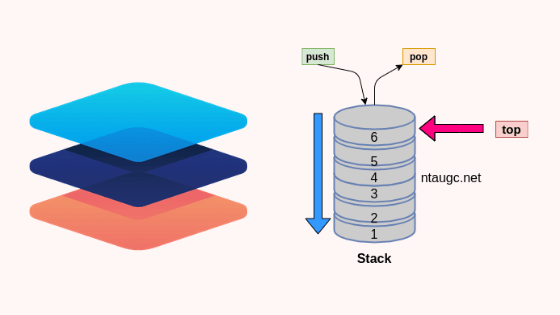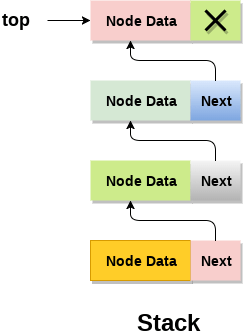Stacks
A Stack is a linear data structure that follows the LIFO (Last-In-First-Out) principle. Stack has one end, whereas the Queue has two ends (front and rear). It contains only one pointer top pointer pointing to the topmost element of the
stack. Whenever an element is added in the stack, it is added on the top of the stack, and the element can be deleted only from the stack.
In other words, a stack can be defined as a container in which insertion and deletion can be done
from the one end known as the top of the stack.

Standard Stack Operation
The following are some common operations implemented on the stack:- push(): When we insert an element in a stack then the operation is known as a push. If the stack is full then the overflow condition occurs.
- pop(): When we delete an element from the stack, the operation is known as a pop. If the stack is empty means that no element exists in the stack, this state is known as an underflow state.
- isEmpty(): It determines whether the stack is empty or not.
- isFull(): It determines whether the stack is full or not.'
- peek(): It returns the element at the given position.
- count(): It returns the total number of elements available in a stack.
- change(): It changes the element at the given position.
- display(): It prints all the elements available in the stack.
Array Implementation Of Stack
In array implementation, the stack is formed by using the array. All the operations regarding the stack are performed using arrays
Adding an element onto the stack (push operation)
Adding an element into the top of the stack is referred to as push operation. Push operation involves following two steps.
- Increment the variable Top so that it can now refere to the next memory location.
- Add element at the position of incremented top. This is referred to as adding new element at the top of the stack.
Stack is overflown when we try to insert an element into a completely filled stack therefore, our main function must always avoid stack overflow condition.
ALGORITHM
begin
if top = n then stack full
top = top + 1
stack (top) : = item;
end
Time Complexity : o(1)
Deletion of an element from a stack (Pop operation)
Deletion of an element from the top of the stack is called pop operation. The value of the variable top will be incremented by 1 whenever an item is deleted from the stack. The top most element of the stack is stored in an another variable
and then the top is decremented by 1. the operation returns the deleted value that was stored in another variable as the result.
The underflow condition occurs when we try to delete an element from an already empty stack.
ALGORITHM
begin
if top = 0 then stack empty;
item := stack(top);
top = top - 1;
end;
Time Complexity : o(1)
Visiting each element of the stack (Peek operation)
Peek operation involves returning the element which is present at the top of the stack without deleting it. Underflow condition can occur if we try to return the top element in an already empty stack.
ALGORITHM
PEEK (STACK, TOP)
Begin
if top = -1 then stack empty
item = stack[top]
return item
End
Time complexity: o(n)
Linked list implementation of stack
Instead of using array, we can also use linked list to implement stack. Linked list allocates the memory dynamically. However, time complexity in both the scenario is same for all the operations i.e. push, pop and peek.
In linked list implementation of stack, the nodes are maintained non-contiguously in the memory. Each node contains a pointer to its immediate successor node in the stack. Stack is said to be overflown if the space left in the memory heap
is not enough to create a node.

The top most node in the stack always contains null in its address field.
Adding a node to the stack (Push operation)
Adding a node to the stack is referred to as push operation. Pushing an element to a stack in linked list implementation is different from that of an array implementation. In order to push an element onto the stack, the following steps are involved.
- Create a node first and allocate memory to it.
- If the list is empty then the item is to be pushed as the start node of the list. This includes assigning value to the data part of the node and assign null to the address part of the node
- If there are some nodes in the list already, then we have to add the new element in the beginning of the list (to not violate the property of the stack). For this purpose, assign the address of the starting element to the address field of the new node and make the new node, the starting node of the list.
Time Complexity : o(1)
Deleting a node from the stack (POP operation)
Deleting a node from the top of stack is referred to as pop operation. Deleting a node from the linked list implementation of stack is different from that in the array implementation. In order to pop an element from the stack, we need to follow the following steps :
- Check for the underflow condition: The underflow condition occurs when we try to pop from an already empty stack. The stack will be empty if the head pointer of the list points to null.
- Adjust the head pointer accordingly: In stack, the elements are popped only from one end, therefore, the value stored in the head pointer must be deleted and the node must be freed. The next node of the head node now becomes the head node.
Time Complexity : o(n)
Display the nodes (Traversing)
Displaying all the nodes of a stack needs traversing all the nodes of the linked list organized in the form of stack. For this purpose, we need to follow the following steps.
- Copy the head pointer into a temporary pointer.
- Move the temporary pointer through all the nodes of the list and print the value field attached to every node.
Time Complexity : o(n)
Practice Problems On Stacks
- Infix to Postfix Conversion using Stack
- Prefix to Infix Conversion
- Prefix to Postfix Conversion
- Postfix to Prefix Conversion
- The Stock Span Problem
- Check for balanced parentheses in an expression
- Evaluation of Postfix Expression
- Maximum product of indexes of next greater on left and right
- Print next greater number of Q queries
- Delete middle element of a stack
